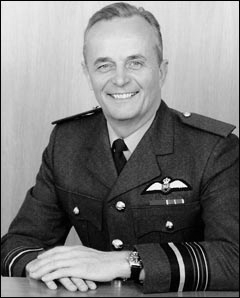Air of Authority - A History of RAF Organisation
 John Frederick
b: 27 Oct 1937 r: 10
Jan 1998
d: 9 Jan 2008
John Frederick
b: 27 Oct 1937 r: 10
Jan 1998
d: 9 Jan 2008
GBE – 14 Jun 1997 (CBE – 31 Dec 1987), KCB – 31 Dec 1992 (CB – 31 Dec 1990), FRAeS - 1997.
Fg Off: 29 Jul 1958, Flt Lt: 29 Jan 1961, Sqn Ldr: 1 Jul 1967, Wg Cdr: 1 Jul 1975, Gp Capt: 1 Jan 1980, A/Cdre: 1 Jan 1986, AVM: 1 Jan 1989, AM: 5 Oct 1992, ACM: 4 Apr 1995.
Photo courtesy - Jeff Jefford
xx Sep 1955: Flight Cadet, 'C' Sqn, RAF College.
29 Jul 1958: Appointed to a Permanent Commission.
xx xxx 1958: Pilot, No 83 Sqn.
xx xxx xxxx: Pilot, No 44 Sqn.
xx xxx xxxx: Pilot, No IX Sqn.
xx xxx 1964: QFI, No 6 Flying Training School, Acklington.
xx xxx 1967: Staff, Officer and Aircrew Selection Centre, Biggin Hill.
xx xxx 1970: Attended RAF Staff College.
xx xxx 1970: CFI, No 230 OCU. RAF Finningley or Waddington?
xx xxx 1971: Flight Commander, No 27 Sqn.
xx xxx xxxx: Officer Commanding, No 27 Sqn.
20 Jun 1977: FP4, Directorate of Forward Policy.
21 Sep 1979: Deputy Director of Air Staff Plans.
1 Apr 1982: Officer Commanding, RAF Akrotiri.
4 May 1984: Staff Officer, MoD.
2 Jan 1985: Director of Air Staff Briefing & Co-ordination.
15 Nov 1985: Chief of Special Weapons Branch, HQ SHAPE.
3 Feb 1989: Assistant Chief of the Defence Staff (Policy & Nuclear).
18 Jan 1991: Director-General of Training.
5 Oct 1992: AOC in C, RAF Support Command.
1 Apr 1994: Chief of Staff/AOC, Directly Administered Units, HQ Logistics Command.
xx xxx 1995: Vice Chief of the Defence Staff
Educated at Dulwich College, he entered the RAF through the RAF College at Cranwell in 1955, attaining the rank of Senior Flight Cadet before graduating in 1958. He joined the V-Bomber force as a Vulcan pilot, initially on 83 Squadron at RAF Waddington and subsequently with 44 also at Waddington and eventually No IX at Coningsby. This extended period on Vulcans came to an end when he went to the CFS in 1964, qualifying as a QFI. After a spell on instructional duties, his flying tours ceased when he was posted to Biggin Hill as part of the selection team at OASC and then attendance on the Staff course at Bracknell.
His return to flying duties also brought with it a return to the Vulcan but this time in an instructional role as CFI at No 230 OCU, Waddington. In 1973 he moved across to RAF Scampton when he took up the post of Flight Commander on the newly reformed No 27 Squadron. This squadron had been part of the nuclear deterrent force until the year before but had been disbanded as a result of the transfer of the deterrence commitment to the Royal Navy. It was reformed in November 1973 still equipped with Vulcans but in the Strategic Reconnaissance role. It was not too long into this tour, that he received promotion to Wing Commander and took over as OC, No 27 Squadron.
Two further staff tours followed before he took over command of RAF Akrotiri in Cyprus. Appointments then followed at MoD (Air), SHAPE in Belgium and on the Central Defence Staff in London before taking over as Director-General of Training. This post gave him a good grounding for his next post, that of AOC in C Support Command.
The separation of RAF Support Command into Personnel & Training Command and Logistics Command also saw an end to a dedicated AOC in C in this area, as control of these new Commands was invested in Members of the Air Council, namely the Air Member for Personnel (PTC) and the newly redesignated Air Member for Logistics (ex Air Member for Supply and Organisation). As a result Sir John found himself 'moved down' as he took up the duties of Chief of Staff and AOC, DAU's within the new Logistics Command. However, this situation did not last long as within a year he was promoted to ACM and became Vice Chief of the Defence Staff. On leaving RAF Brampton he was driven away in style in the Humber Snipe, originally used by Field Marshal Montgomery between D-Day and the collapse of Berlin.
In retirement he was appointed Chairman of Rosetta Global Communications, a consortium comprising of British Aerospace, British Telecom and Lockheed Martin to lead their bid for Skynet 5, an advanced military communications system. He also became involved in local matters in Northumberland as president of the north-east region of the RAF Association, chairman of the the Alnwick Civic Society's planning committee and a trustee of the Chillingham Wild Cattle Association as well as being a vice-chairman of the council of Newcastle University. He was also an avid builder of large-scale model aircraft and was president of the Heavy Model Aircraft Society.
This page was last updated on 16/03/25©
![]() C V D Willis
[Top of Page]
F G Willock
C V D Willis
[Top of Page]
F G Willock
![]()